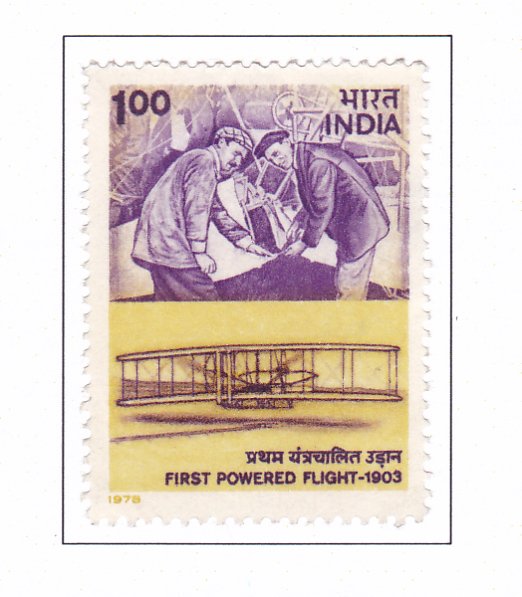75th Anniversary of Powered Flight

Technical Data
| Date of Issue | December 23, 1978 |
|---|---|
| Denomination | Rs. 1 |
| Quantity | 2,000,000 |
| Perforation | comb 13 x 13½ |
| Printer | Security Printing Press, Nashik |
| Watermark | Asokan Capital Multiple [SL] |
| Colors | Multicolor |
| Catalog Codes |
Michel IN 779 Stamp Number IN 815 Yvert et Tellier IN 576 Stanley Gibbons IN 905 |
| Themes | Aircraft | Anniversaries and Jubilees | Aviation | Famous people | Inventors | Pilots |
On a cold and windy day 75 years ago, one of humanity’s oldest and most audacious aspirations— to soar through the skies like birds—was finally realized. It was December 17, 1903, when Wilbur and Orville Wright piloted their heavier-than-air flying machine from a remote spot of land protruding into the Atlantic Ocean, known as Kitty Hawk, in North Carolina. Crafted from silk and wood, their flimsy plane, with Orville at the controls, lifted off from the sandy terrain and took to the air. The historic flight lasted a mere 12 seconds. It marked the first instance in history where a powered aircraft, carrying a human, independently rose into the air and maintained flight without decelerating.
The Wright brothers made three additional flights that day, alternating roles as pilots. During the fourth flight, Wilbur achieved the longest distance, covering 852 feet in 59 seconds. In 1904, they made significant modifications to their aircraft, with a total of 105 landings recorded. The subsequent year, they focused on enhancements and refinements rather than drastic alterations. By 1907, their upgraded engine provided 50 percent more power than its predecessor, enabling the aircraft to carry two individuals, fuel, and a 100-pound payload.
Continuing their efforts, the Wright brothers remained dedicated to aviation, with Wilbur setting a world record for flight in September 1908 in France, covering 52 miles and staying airborne for one hour, 31 minutes, and 25 seconds. Born into a family of five children, the Wright brothers’ interest in flight stemmed from their fascination with bicycles and printing presses. While their siblings pursued traditional education, Wilbur (born 1867) and Orville (born 1871) delved into the study of aviation.
Their success was not instantaneous nor coincidental; it was the result of meticulous planning and dedication. Their work was greatly influenced by the contributions of numerous predecessors, and the field of aeronautics had been established well before their endeavors began in earnest. Despite setbacks, including Wilbur’s death from typhoid in 1912, Orville continued their work. In 1913, he received the prestigious Collier Trophy for his invention of a device to automatically stabilize airplanes. Orville passed away in 1948, leaving behind a lasting legacy in aviation history.
